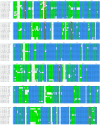Amplicon_sorter: A tool for reference-free amplicon sorting based on sequence similarity and for building consensus sequences
- PMID: 35261737
- PMCID: PMC8888255
- DOI: 10.1002/ece3.8603
Amplicon_sorter: A tool for reference-free amplicon sorting based on sequence similarity and for building consensus sequences
Abstract
Oxford Nanopore Technologies (ONT) is a third-generation sequencing technology that is gaining popularity in ecological research for its portable and low-cost sequencing possibilities. Although the technology excels at long-read sequencing, it can also be applied to sequence amplicons. The downside of ONT is the low quality of the raw reads. Hence, generating a high-quality consensus sequence is still a challenge. We present Amplicon_sorter, a tool for reference-free sorting of ONT sequenced amplicons based on their similarity in sequence and length and for building solid consensus sequences.
Keywords: DNA barcoding; Oxford Nanopore Technologies; amplicon sequencing; biodiversity; consensus; metabarcoding; metagenetics; replacing Sanger.
© 2022 The Authors. Ecology and Evolution published by John Wiley & Sons Ltd.
Conflict of interest statement
The authors declare no conflicts of interest.
Figures






Similar articles
-
NGSpeciesID: DNA barcode and amplicon consensus generation from long-read sequencing data.Ecol Evol. 2021 Jan 11;11(3):1392-1398. doi: 10.1002/ece3.7146. eCollection 2021 Feb. Ecol Evol. 2021. PMID: 33598139 Free PMC article.
-
High accuracy meets high throughput for near full-length 16S ribosomal RNA amplicon sequencing on the Nanopore platform.PNAS Nexus. 2024 Oct 9;3(10):pgae411. doi: 10.1093/pnasnexus/pgae411. eCollection 2024 Oct. PNAS Nexus. 2024. PMID: 39386005 Free PMC article.
-
Nano-RECall provides an integrated pipeline for HIV-1 drug resistance testing from Oxford Nanopore sequence data.Trop Med Int Health. 2023 Mar;28(3):186-193. doi: 10.1111/tmi.13851. Epub 2023 Jan 13. Trop Med Int Health. 2023. PMID: 36599816 Free PMC article.
-
Adaptation of Oxford Nanopore technology for hepatitis C whole genome sequencing and identification of within-host viral variants.BMC Genomics. 2021 Mar 2;22(1):148. doi: 10.1186/s12864-021-07460-1. BMC Genomics. 2021. PMID: 33653280 Free PMC article.
-
Long-read sequencing in deciphering human genetics to a greater depth.Hum Genet. 2019 Dec;138(11-12):1201-1215. doi: 10.1007/s00439-019-02064-y. Epub 2019 Sep 19. Hum Genet. 2019. PMID: 31538236 Review.
Cited by
-
Insights into mycobacteriome composition in Mycobacterium bovis-infected African buffalo (Syncerus caffer) tissue samples.Sci Rep. 2024 Jul 30;14(1):17537. doi: 10.1038/s41598-024-68189-x. Sci Rep. 2024. PMID: 39080347 Free PMC article.
-
The newest Oxford Nanopore R10.4.1 full-length 16S rRNA sequencing enables the accurate resolution of species-level microbial community profiling.Appl Environ Microbiol. 2023 Oct 31;89(10):e0060523. doi: 10.1128/aem.00605-23. Epub 2023 Oct 6. Appl Environ Microbiol. 2023. PMID: 37800969 Free PMC article.
-
Robot-Aided Measurement of Insect Diversity on Vegetation Using Environmental DNA.Ecol Evol. 2025 May 7;15(5):e71391. doi: 10.1002/ece3.71391. eCollection 2025 May. Ecol Evol. 2025. PMID: 40342700 Free PMC article.
-
Metagenomic evaluation of bacteria in drinking water using full-length 16S rRNA amplicons.J Water Health. 2024 Aug;22(8):1429-1443. doi: 10.2166/wh.2024.090. Epub 2024 Jul 30. J Water Health. 2024. PMID: 39212280
-
First record of mermithid parasitism in adult biting midges, Culicoides huffi (Diptera: Ceratopogonidae), collected from Southern Thailand, with ultrastructural and molecular characterization.Parasit Vectors. 2025 Jul 28;18(1):303. doi: 10.1186/s13071-025-06958-x. Parasit Vectors. 2025. PMID: 40722115 Free PMC article.
References
-
- Bolyen, E. , Rideout, J. R. , Dillon, M. R. , Bokulich, N. A. , Abnet, C. C. , Al‐Ghalith, G. A. , Alexander, H. , Alm, E. J. , Arumugam, M. , Asnicar, F. , Bai, Y. , Bisanz, J. E. , Bittinger, K. , Brejnrod, A. , Brislawn, C. J. , Brown, C. T. , Callahan, B. J. , Caraballo‐Rodríguez, A. M. , Chase, J. , … Caporaso, J. G. (2019). Reproducible, interactive, scalable and extensible microbiome data science using QIIME 2. Nature Biotechnology, 37(8), 852–857. 10.1038/s41587-019-0209-9 - DOI - PMC - PubMed
-
- Chan, W. S. , Au, C. H. , Lam, H. Y. , Wang, C. L. N. , Ho, D.‐N.‐Y. , Lam, Y. M. , Chu, D. K. W. , Poon, L. L. M. , Chan, T. L. , Zee, J.‐S.‐T. , Ma, E. S. K. , & Tang, B. S. F. (2020). Evaluation on the use of Nanopore sequencing for direct characterization of coronaviruses from respiratory specimens, and a study on emerging missense mutations in partial RdRP gene of SARS‐CoV‐2. Virology Journal, 17, 183. 10.1186/s12985-020-01454-3 - DOI - PMC - PubMed
Associated data
LinkOut - more resources
Full Text Sources

